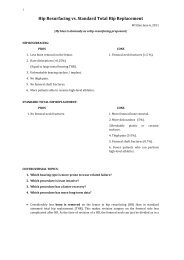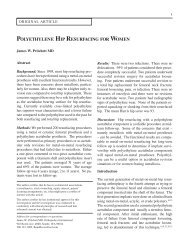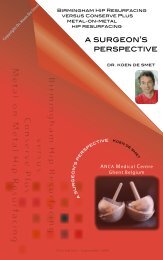Hip and Knee Arthroplasty - Surface Hippy Guide to Hip Resurfacing
Hip and Knee Arthroplasty - Surface Hippy Guide to Hip Resurfacing
Hip and Knee Arthroplasty - Surface Hippy Guide to Hip Resurfacing
You also want an ePaper? Increase the reach of your titles
YUMPU automatically turns print PDFs into web optimized ePapers that Google loves.
APPENDIX 2<br />
Patient Consent <strong>and</strong> Confidentiality <strong>Guide</strong>lines<br />
Patient Consent<br />
The Registry obtains consent <strong>to</strong> include<br />
information from individuals undergoing joint<br />
replacement. This is done by using the ‘opt off’<br />
approach. The implementation of the new<br />
Commonwealth Legislation at the end of 2001<br />
resulted in the Registry meeting the Privacy<br />
Commission <strong>to</strong> ensure that the system used for<br />
patient consent is within the privacy guidelines.<br />
• Data Management & Analysis Centre<br />
Staff including data assistants <strong>and</strong> data<br />
manager, statisticians <strong>and</strong> programmers.<br />
Declaration of the project as a Quality Assurance<br />
Activity ensures that Registry <strong>and</strong> DMAC staff are<br />
bound <strong>to</strong> maintain confidentiality. Confidentiality<br />
not only applies <strong>to</strong> individual patients but also<br />
includes surgeons <strong>and</strong> hospitals.<br />
Using this approach, patients are provided with a<br />
Patient Information Sheet. This explains clearly<br />
what information is required, how it is collected<br />
<strong>and</strong> the avenues <strong>to</strong> take should an individual not<br />
want their information included in the Registry.<br />
The information is provided <strong>to</strong> patients by<br />
surgeons <strong>and</strong> hospitals prior <strong>to</strong> surgery. To<br />
accommodate patients that may wish <strong>to</strong> opt off,<br />
have enquires or wish <strong>to</strong> discuss any issues a<br />
freecall number is available for the Registry.<br />
Patient Confidentiality<br />
Joint replacement patients will not be contacted<br />
directly by the Registry. No individual patient will<br />
be identified during analysis or in the reports <strong>and</strong><br />
publications produced by the Registry. Patient<br />
operative <strong>and</strong> prostheses data will be managed in<br />
accordance with the <strong>Guide</strong>lines for the Protection<br />
of Privacy in the Conduct of Medical Research.<br />
Personal data collected are for use by the AOA<br />
National Joint Replacement Registry only.<br />
Further <strong>to</strong> this the Registry is a Federal Quality<br />
Assurance Activity (see below) <strong>and</strong> all<br />
information is protected.<br />
Data Management & Confidentiality<br />
The Data Management & Analysis Centre,<br />
University of Adelaide undertakes data entry,<br />
validation <strong>and</strong> analysis <strong>and</strong> provides secure data<br />
s<strong>to</strong>rage.<br />
The DMAC was established in 1993. Professor<br />
Philip Ryan, Professor in Public Health, heads<br />
DMAC. The centre staff includes data managers,<br />
database programmers, statisticians <strong>and</strong> data<br />
assistants. It is engaged in an increasing variety<br />
of work, including clinical trials,<br />
pharmacoepidemiological studies, consultations<br />
<strong>and</strong> cohort studies.<br />
The list of personnel with access <strong>to</strong> identified<br />
Registry information is as follows:<br />
• Direc<strong>to</strong>r, Professor Stephen Graves<br />
• Deputy Direc<strong>to</strong>r, Mr David Davidson<br />
• Deputy Direc<strong>to</strong>r, Mr Richard de Steiger<br />
• Coordina<strong>to</strong>r, Ms Ann Tomkins<br />
DMAC has security systems <strong>to</strong> restrict access <strong>to</strong><br />
DMAC <strong>and</strong> Registry staff only. There are policies<br />
<strong>and</strong> procedures in place as well as software<br />
barriers <strong>to</strong> protect personal information. These<br />
include the use of codes, passwords <strong>and</strong><br />
encryption.<br />
The proforma used for data collection is s<strong>to</strong>red in<br />
a secure locked room at the DMAC. After a<br />
period of time the forms are scanned <strong>and</strong><br />
electronically s<strong>to</strong>red. As with all data these will<br />
be securely s<strong>to</strong>red. All data will be retained in<br />
accordance with good scientific practice.<br />
Surgeon Confidentiality<br />
Surgeon confidentiality is assured. The purpose<br />
of the Registry is <strong>to</strong> provide demographic <strong>and</strong><br />
outcome information relevant <strong>to</strong> joint<br />
replacement surgery. Surgeon name is not<br />
recorded in the Registry database. In addition <strong>to</strong><br />
this, the AOA Registry Management Committee<br />
made a decision in Oc<strong>to</strong>ber 1999 <strong>to</strong> remove<br />
surgeon name from Registry forms. The Board<br />
of the AOA ratified this decision <strong>and</strong> consequently<br />
Registry staff blackout surgeon name, whether it<br />
is h<strong>and</strong> written or printed on the hospital patient<br />
identification, on all forms received by the<br />
Registry.<br />
It is an important Registry function <strong>to</strong> provide a<br />
service <strong>to</strong> surgeons that allows them <strong>to</strong> moni<strong>to</strong>r<br />
<strong>and</strong> audit their own performance. For this<br />
reason surgeons have a choice <strong>to</strong> identify<br />
themselves by code which can linked <strong>to</strong> their<br />
procedures. This is optional <strong>and</strong> there is no<br />
requirement <strong>to</strong> provide the surgeon code. These<br />
codes are provided <strong>to</strong> surgeons by the AOA.<br />
The intention is <strong>to</strong> provide surgeons with access<br />
<strong>to</strong> their own information through secure internet<br />
access. As yet the software has not been<br />
developed that would allow this <strong>to</strong> occur. It is<br />
important <strong>to</strong> emphasise that surgeons have the<br />
choice of using their code <strong>and</strong> that surgeon name<br />
is not recorded in the database <strong>and</strong> is<br />
permanently removed from Registry forms.<br />
197






